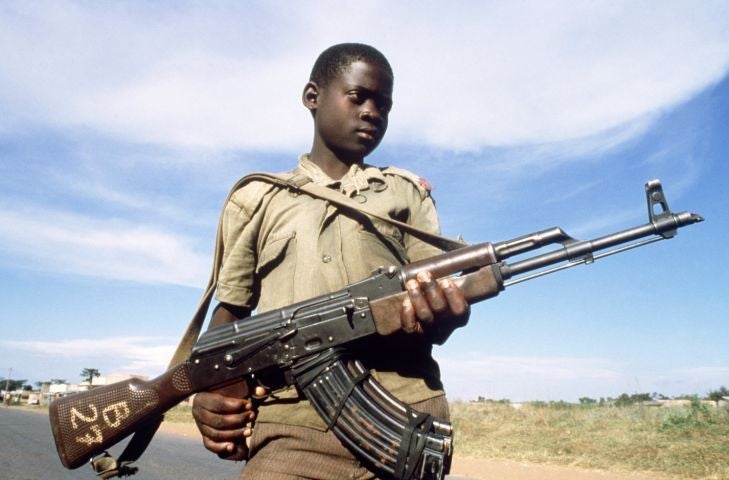Uganda: Visiting the rehabilitation centre using art as therapy for children freed from a brutal militia
The centre is helping abductees come to terms with their horrendous past

The pictures are drawn in a childish hand, but they are visions that no child should have to witness: militia shooting captives tied to trees; army helicopters above firing on their enemy; the central African bush in flames.
These are all artworks produced by children held in captivity after they, or their parents, were abducted by the feared Lord’s Resistance Army (LRA) in northern Uganda. Many of those taken spent years in the bush, constantly on the move to evade capture, walking barefoot carrying heavy loads for the commanders and even fighting for the militia.
At the Ugandan Children of War Rehabilitation Centre in Gulu, art is used as therapy, along with other interventions, to help abductees come to terms with their horrendous past, and to cope with the stigma surrounding them on their return.
Ofono Opondo was abducted when he was 10. Now 28, he is one of the more recent returnees to Uganda, escaping from the Democratic Republic of Congo, another area where the LRA had a presence. He was forced to fight soon after his capture, and admits he may have killed in crossfire under orders.
“Thinking of the past and what I have gone through and done, it still comes as a nightmare, and sometimes I find myself shivering. You keep feeling that guilt, you are not free,” he says.
It is believed that around 30,000 people have been abducted since 1986 by the rebel army led by warlord Joseph Kony. This includes thousands of children – boys to become child soldiers and girls to become “forced” wives. More than 1,200 children are understood to have been born in captivity to these young “wives”.
To say they are not universally welcomed back by their own community is an understatement, with many seeing the abductees as perpetrators rather than victims, despite their being wrenched from their families at a tender age.
On his return, Ofono’s father rejected him and he now sees the centre as his home. “The way I was welcomed here – I wish my community would welcome me like that. You are treated like a real person, not someone from the Bush.”
The centre in Gulu has welcomed 15,000 former abductees like Ofono through its doors since 1995. Although many of them have physical injuries – from gunshots, bomb splinters embedded in their bodies, brutal canings – it is the psychological damage that the centre attempts to repair. Many abductees were forced to torture people from their home villages on raids for food and cash, so it is unsurprising there is resentment when they come home.
Most of the returnees stay in the centre for between a week and three months, though a number have stayed six months, and one for 19 years.
A feeling of a lack of identity is a major issue for some. “Children born in captivity ask ‘am I Ugandan? Am I Sudanese? Am I a Bush person?’ The majority do not know who their father is,” says Harriet Aloyo, a social worker who heads the centre, which is run by NGO World Vision.
The returnees, known as formerly abducted persons (FAPs) find it easier to socialise among themselves and often return to the centre even though it is months and years since they lived there.
One of them is Joyce Akot, now 39. She was abducted when she was 15, and was forced to be a wife to a much older soldier a week after she arrived. “He was wild. He beat me unconscious twice,” she says.
She bore him a daughter who suffered a brain injury from a wound to the head in an ambush when she was five. After escaping, Joyce sought support from the centre, as well as medical treatment for her daughter, now 16. “When I came back I didn’t know where to stay or what to do. They guided me, reconnected with my family. I still come back – it’s like another home.”
Within the centre there is a smaller charity called Watye Ki Gen which helps improve the women’s job prospects. It’s run by Angela Atim, who was abducted aged 15 from her Catholic boarding school by the LRA. Providing for family is often difficult for women returnees, and many remarry. However, a woman can face rejection if her new husband finds that his wife has “Bush children”. This happened to Joyce and her daughter. “He said ‘it’s me or her’ and I chose her,” she says. It is issues such as this, according to Ms Atim, that mean women are still “suffering”.
It is now quieter, with fewer returnees, meaning that the staff can concentrate on follow-up activities with the FAPs, and fostering community relations – including going to schools and churches to emphasise the importance of forgiveness and acceptance.
However, that does not mean that things are easy. “People think the war has ended but to me the post-war conflict is even worse than the war,” says Ms Atim.
Ms Aloyo agrees that there is a lot of work still to do. “These survivors are resilient [and] strong,” she says. “But there is still so much to be done.”
Join our commenting forum
Join thought-provoking conversations, follow other Independent readers and see their replies
Comments